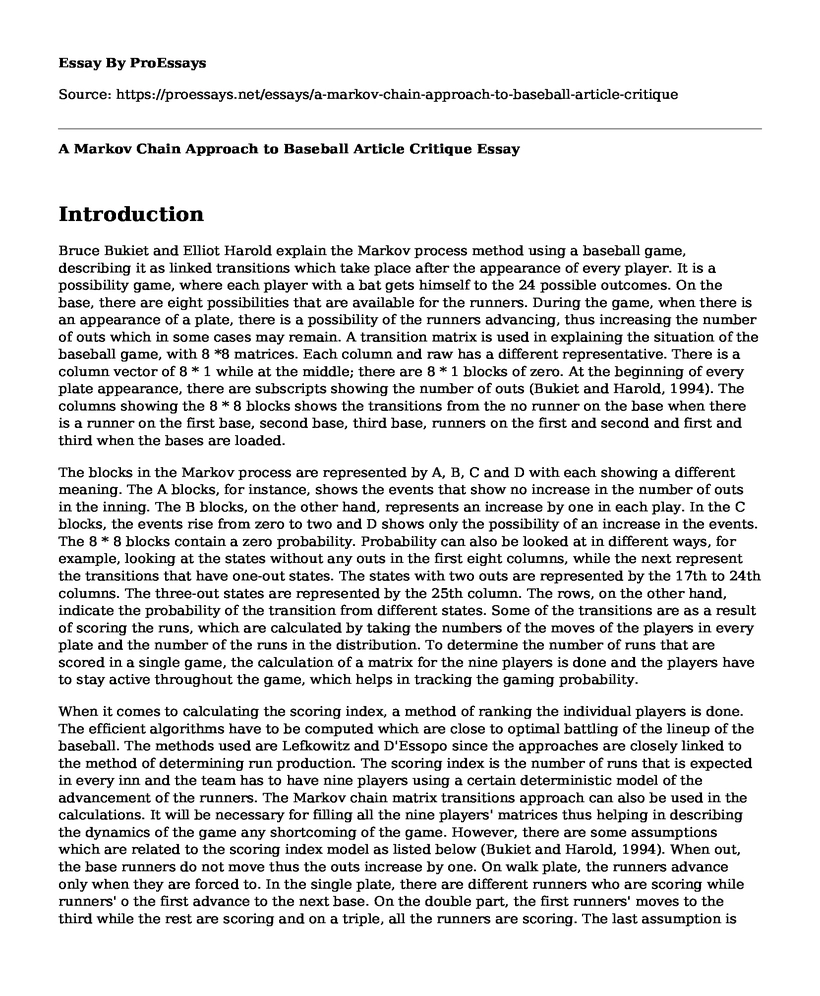Introduction
Bruce Bukiet and Elliot Harold explain the Markov process method using a baseball game, describing it as linked transitions which take place after the appearance of every player. It is a possibility game, where each player with a bat gets himself to the 24 possible outcomes. On the base, there are eight possibilities that are available for the runners. During the game, when there is an appearance of a plate, there is a possibility of the runners advancing, thus increasing the number of outs which in some cases may remain. A transition matrix is used in explaining the situation of the baseball game, with 8 *8 matrices. Each column and raw has a different representative. There is a column vector of 8 * 1 while at the middle; there are 8 * 1 blocks of zero. At the beginning of every plate appearance, there are subscripts showing the number of outs (Bukiet and Harold, 1994). The columns showing the 8 * 8 blocks shows the transitions from the no runner on the base when there is a runner on the first base, second base, third base, runners on the first and second and first and third when the bases are loaded.
The blocks in the Markov process are represented by A, B, C and D with each showing a different meaning. The A blocks, for instance, shows the events that show no increase in the number of outs in the inning. The B blocks, on the other hand, represents an increase by one in each play. In the C blocks, the events rise from zero to two and D shows only the possibility of an increase in the events. The 8 * 8 blocks contain a zero probability. Probability can also be looked at in different ways, for example, looking at the states without any outs in the first eight columns, while the next represent the transitions that have one-out states. The states with two outs are represented by the 17th to 24th columns. The three-out states are represented by the 25th column. The rows, on the other hand, indicate the probability of the transition from different states. Some of the transitions are as a result of scoring the runs, which are calculated by taking the numbers of the moves of the players in every plate and the number of the runs in the distribution. To determine the number of runs that are scored in a single game, the calculation of a matrix for the nine players is done and the players have to stay active throughout the game, which helps in tracking the gaming probability.
When it comes to calculating the scoring index, a method of ranking the individual players is done. The efficient algorithms have to be computed which are close to optimal battling of the lineup of the baseball. The methods used are Lefkowitz and D'Essopo since the approaches are closely linked to the method of determining run production. The scoring index is the number of runs that is expected in every inn and the team has to have nine players using a certain deterministic model of the advancement of the runners. The Markov chain matrix transitions approach can also be used in the calculations. It will be necessary for filling all the nine players' matrices thus helping in describing the dynamics of the game any shortcoming of the game. However, there are some assumptions which are related to the scoring index model as listed below (Bukiet and Harold, 1994). When out, the base runners do not move thus the outs increase by one. On walk plate, the runners advance only when they are forced to. In the single plate, there are different runners who are scoring while runners' o the first advance to the next base. On the double part, the first runners' moves to the third while the rest are scoring and on a triple, all the runners are scoring. The last assumption is the home run with all base runners and the battlers scoring.
To represent the runs made by the payers, vectors are required and when computing, a matrix U begins with which has 21 rows and they indicate a total of zero to 20 runs and there are 25 columns. The numbers of runs made are shown by the rows while the columns, on the other hand, shows the current state which is the basis between the runners and the out numbers that are present in the innings. When there is a transition between the plays, it is an indication of a run score and the probability of the occurrence of the same situation is taken to the next row.
Conclusion
In conclusion, the authors have been able to show how the performance of baseball game can be calculated using different methods. The transitions from one game to the next in baseball help in understanding how the layers perform. The performance of each player has to be calculated using the 8 * 8 matrix method and the players have to be in the game all through. The calculation can be used to predict the outcome of different basketball.
Reference
Bukiet, B. and Harold, E. (1994).A Marvok Chain Approach to Baseball. Operations Research, 14-17.
Cite this page
A Markov Chain Approach to Baseball Article Critique. (2022, May 16). Retrieved from https://proessays.net/essays/a-markov-chain-approach-to-baseball-article-critique
If you are the original author of this essay and no longer wish to have it published on the ProEssays website, please click below to request its removal:
- Physical Education Paper Sample: Effects of Body Mass and Height on a Volleyball Athlete
- Colleges Should Not Experience Football Ban Essay
- Interview with David Beckham
- How the Players on the 1998 French National Team Became Symbols of a "France Metisee" - Essay Sample
- Essay Sample on College Athletes: To Pay or Not to Pay?
- College Athletes: Should They Be Paid? - Essay Sample
- Essay Example on Supplements: Enhancing Exercise & Athletic Performance







